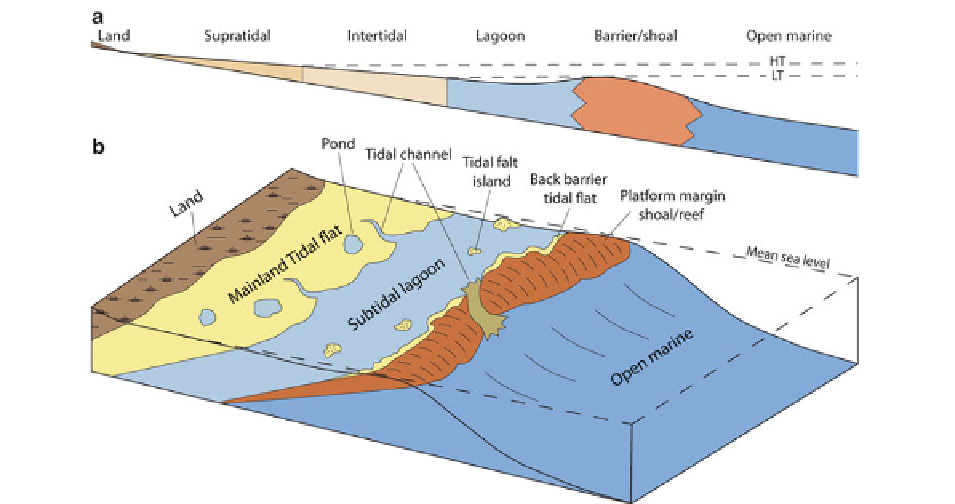Geology Reference
In-Depth Information
Fig. 21.1
Carbonate platform paleogeography and various
depositional environments of a tidal system. (
a
) A gently
sloping carbonate ramp profi le showing depositional environ-
ments and their relationship to sea level (
b
) Block diagram of a
carbonate shelf showing various areas of tidal fl at development.
Note that platform margin barrier/shoal and tidal fl at environ-
ments are dissected by tidal channels. Abbreviations:
HT
high
tide,
LT
low tide
known as “sabkha” (Fig.
21.2a
) named after the evapo-
ritic supratidal fl ats of the southern part of the Persian
Gulf. In humid climate, supratidal fl at is characterized
by an extensive freshwater marsh (Fig.
21.2b
).
Tidal fl ats normally develop in shorelines protected
from waves and fl uvial-deltaic infl uence and are the
most extensive in mainland coasts, but narrower tidal
fl ats occur in the back of islands or carbonate barriers/
shoals at the platform margin (Fig.
21.1b
). In ancient
carbonate platforms, the back barrier tidal fl ats could
have been quite extensive (see the Precambrian tidalites
in Sect.
21.7.1
). Ancient carbonate tidal fl ats could have
also developed on low-relief supratidal islands and
intertidal banks surrounded by subtidal environment
(Pratt and James
1986
; Pratt
2010
) . On a windward-
facing tidal fl at, beach ridges at the seaward edge of
intertidal fl at (Fig.
21.2b
) or distinct barrier islands
separated from the intertidal fl ats by a subtidal lagoon
of variable width (Fig.
21.2a
), analogous to siliciclastic
barrier islands, may develop (Shinn
1986
) . In unpro-
tected coasts exposed to high energy waves, such as
the eastern and western parts of the Persian Gulf Abu
Dhabi Embayment and the windward northern side of
the Persian Gulf barrier islands (Purser and Evans
1973
) , tidal fl ats are not well developed. In these coasts,
the shoreline is covered by high energy beach environ-
ment. In cool-water settings, too, tidal fl ats are scarce
and the shoreline deposits are characterized by high
energy sand- to gravel-size carbonate beach facies com-
monly backed by carbonate aeolianites (James
1997
) .
21.4
Processes of Sedimentation
Carbonate sediments form
in situ
, mainly by carbonate
secreting organisms in the subtidal environments
(e.g. Wilson
1975
; Flügel
2010
); part of the subtidal
carbonate sediment is transported landward by storms
and tidal currents and deposited in the intertidal and
supratidal environments of the tidal fl at system. In the
subtidal lagoon, current energy and grain size nor-
mally decreases seaward toward the deeper outer
shelf-lagoon. In this setting, quiet water condition
results in accumulation of lime mud of biological
(e.g. Robbins and Blackwelder
1992
; Pratt
2001
) and
possibly chemical origin (Shinn et al.
1989
) , which may
be stabilized by sessile organisms, such as seagrass
and calcareous algae. In the subtidal and adjacent
intertidal settings, bioturbation by burrowing organisms
(except for extreme conditions, such as hypersalinity

